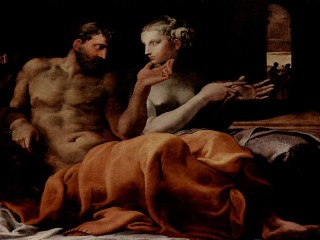
Francesco Primaticcio biography
Date of birth : 1504-04-30
Date of death : 1570-09-14
Birthplace : Bologna, Italy
Nationality : Italian
Category : Arhitecture and Engineering
Last modified : 2011-05-09
Credited as : Painter and sculptor, architect,
The Italian painter, sculptor and architect Francesco Primaticcio was instrumental in transplanting mannerist palace decoration from Italy to France and in giving French mannerist art its individual character.
Francesco Primaticcio was born in Bologna on April 30, 1504. He worked in Mantua from 1525 or 1526 until 1532 under Giulio Romano. In the Palazzo del Te, Giulio carried out one of the most elaborate programs of mannerist art in all Italy. He represented a series of mythological scenes and motifs in frescoes and stucco reliefs in a decorative style that his teacher, Raphael, had created only a few years earlier.
In 1532 Primaticcio was called to France to work on the decorations of the royal palace of Francis I at Fontainebleau. He came equipped with all the things Giulio Romano had taught him: a rich vocabulary of classical nymphs and satyrs and Roman gods and goddesses plus the fashionable new mode of paintings combined with stuccoes. Giorgio Vasari in his Lives (2d ed. 1568) states that "the first works of stucco done in France and the first frescoes of any account originated with Primaticcio." Together with II Rosso, Primaticcio developed this tradition in the form that set the general direction of French palace decoration for the next 150 years.
In 1541 the King made Primaticcio one of his chamberlains. Three years later he appointed him abbot of St-Martin at Troyes, a position that carried no duties or responsibilities but an abundance of prestige and money. Meanwhile the King commissioned him to decorate one room after another at Fontainebleau with his paintings and stucco figures.
Gradually, under the influence of Parmigianino, Primaticcio's style began to change. His figures, which until now had had normal proportions, started to become fantastically elongated. Tiny heads appeared on top of long, thin, curving necks. Arms and legs tapered down to tiny hands and feet. These strange creatures lounged languidly and effortlessly in poses that were always elegant though sometimes bizarre. This figure type that Primaticcio created at Fontainebleau was endlessly repeated by French artists throughout the remainder of the 16th century and even into the 17th.
Primaticcio's works in architecture are much less well known. The most striking is the small Grotto of the Pines (ca. 1543) at Fontainebleau. Here sculptured giants appear to grow out of rough-hewn stones, and at the top of each arch the keystone seems about to slip out of place, giving the impression—quite intentionally-that the whole structure might at any moment collapse. Primaticcio designed the circular chapel for Henry II and his wife, Catherine de Medicis (ca. 1560; destroyed), at St-Denis and added a wing, the Aile de la Belle Cheminee (1568), to the palace at Fontainebleau. He died in Paris sometime between May 15 and Sept. 14, 1570.

















